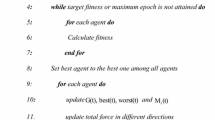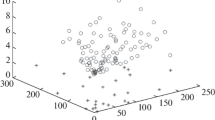Abstract
Recently, the wireless sensor networks (WSNs) found its extensive application in surveillance and target tracking. For these two WSN applications, connectivity and coverage play a major role most particularly for target tracking. A large number of available sensor nodes track targets, during which a massive redundant data gets generated, which may minimize the system performance. Most particularly during the sensor node failure, the major intention of coverage and connectivity optimization model is to select less number of sensor nodes with maximum direct sensor node connectivity. But existing algorithms fail to achieve minimal node selection, therefore to mitigate the barriers of the traditional coverage algorithms, this paper proposed the hybrid Gravitational Search algorithm with social ski-driver (GSA-SSD) based model. This hybrid approach in target based WSN optimizes the coverage and connectivity requirement. By adapting the dynamic behaviour of SSD algorithm, the performance of GSA gets improved. Finally, the relative performance of the proposed hybrid GSA-SSD based optimization model is validated and compared with other optimization algorithms. On the basis of uncovered area rate and a number of sensor nodes the performance is evaluated. The results are implemented in the MATLAB simulation tool. Further, the performance enhancement in terms of uncovered area rate, number of selected active sensors, energy consumption, connectivity and network lifetime is achieved with randomly deployed nodes.













Similar content being viewed by others
References
Abu-Mahfouz AM (2018) Localised information fusion techniques for location discovery in wireless sensor networks. Intern J Sens Netw 26:12–25
Ahmad T, Haque M, Khan AM (2019) An energy-efficient cluster head selection using artificial bees colony optimization for wireless sensor networks. Advances in nature-inspired computing and applications. Springer, Cham, pp 189–203
Ammari HM, Das SK (2012) Centralized and clustered k-coverage protocols for wireless sensor networks. IEEE Trans Comput 61(1):118–133
Aziz AN, Aziz KA, Ismail WZW (2009) Coverage strategies for wireless sensor networks. World Acad Sci Eng Technol 50:145–150
Bi K, Tu K, Gu N, Dong W (2006) Topological hole detection in sensor networks with cooperative neighbors. Proc Intern Conf Syst 00(60533020):1–5
Cheng C-F, Tsai K-T (2017) Encircled belt-barrier coverage in wireless visual sensor networks. Perv Mob Comput 38:233–256
Dahiya S, Singh PK (2019) Energy efficient SOCGO protocol for hole repair node scheduling in reliable sensor system. Wireless Personal Commun pp 1–21
Dash D, Gupta A, Bishnu A, Nandy SC (2014) Line coverage measures in wireless sensor networks. J Parallel Distrib Comput 74(7):2596–2614
Elhoseny M, Tharwat A, Yuan X, Hassanien AE (2018) Optimizing K-coverage of mobile WSNs. Expert Syst Appl 92:142–153
Gorain B, Mandal PS (2017a) Solving energy issues for sweep coverage in wireless sensor networks. Discr Appl Mathematics 228:130–139
Gorain B, Mandal PS (2017b) Solving energy issues for sweep coverage in wireless sensor networks. Discrete Applied Mathematics 228:130–139
Heinzelman WB, Chandrakasan AP, Balakrishnan H (2002) An application-specific protocol architecture for wireless microsensor networks. IEEE Trans Wireless Commun 1(4):660–670
Jehan C, Punithavathani DS (2017) Potential position node placement approach via oppositional gravitational search for fulfill coverage and connectivity in target based wireless sensor networks. Wireless Netw 23(6):1875–1888
Khan I, Mokhtar H and Merabti M (2008) A survey of boundary detection algorithms for sensor networks. In: Proceedings of the 9th Annual Postgraduate Symposium on the Convergence of Telecommunications, Networking and Broadcasting
Kim D, Kim Y, Li D, Seo J (2017) A new maximum fault-tolerance barrier-coverage problem in hybrid sensor network and its polynomial time exact algorithm. Ad Hoc Netw 63:14–19
Krishnan M, Rajagopal V, Rathinasamy S (2018) Performance evaluation of sensor deployment using optimization techniques and scheduling approach for K-coverage in WSNs. Wireless Netw 24(3):683–693
Kulkarni R, Forster A, Venayagamoorthy G (2011) Computational intelligence in wireless sensor networks: a survey. IEEE Commun Surv Tutorials 13(1):68–96
Lehsaini M and Benmahdi MB (2018) An improved k-means cluster-based routing scheme for wireless sensor networks. In: 2018 International Symposium on Programming and Systems (ISPS), IEEE, pp 1–6
Li H, Wang S, Gong M, Chen Q, Chen L (2017) IM 2 DCA: Immune mechanism based multipath decoupling connectivity algorithm with fault tolerance under coverage optimization in wireless sensor networks. Appl Soft Computing 58:540–552
Mansour M, Jarray F (2015) An iterative solution for the coverage and connectivity problem in wireless sensor network. Procedia Comput Sci 63:494–498
Mini S, Udgata S, Sabat S (2014) Sensor deployment and scheduling for target coverage problem in wireless sensor networks. IEEE Sens J 14(3):636–644
Mohamed SM, Hamza HS, Saroit IA (2017) Coverage in mobile wireless sensor networks (M-WSN): a survey. Comput Commun 110:133–150
More A, Raisinghani V (2017) A survey on energy efficient coverage protocols in wireless sensor networks. J King Saud Univ Compu Inform Sci 29(4):428–448
Mostafaei H (2015) Stochastic barrier coverage in wireless sensor networks based on distributed learning automata. Comput Commun 55:51–61
Movassagh M, Aghdasi HS (2017) Game theory based node scheduling as a distributed solution for coverage control in wireless sensor networks. Eng Appl Artif Intell 65:137–146
Rashedi E, Nezamabadi-Pour H, Saryazdi S (2009) GSA: a gravitational search algorithm. Inf Sci 179(13):2232–2248
Rebai M, Le Berre M, Snoussi H, Hnaien F, Khoukhi L (2015) Sensor deployment optimization methods to achieve both coverage and connectivity in wireless sensor networks. Comput Opera Res 59:11–21
Sangwan A, Singh R (2014) Survey on coverage problems in wireless sensor networks. Wireless Pers Commun 80(4):1475–1500
Tharwat A, Gabel T (2019) Parameters optimization of support vector machines for imbalanced data using social ski driver algorithm. Neural Comput Appl 1–4
Wang W, Srinivasan V, Wang B, Chua KC (2008) Coverage for target localization in wireless sensor networks. IEEE Trans Wireless Commun 7(2):667–676
Wang Y, Wu S, Chen Z, Gao X, Chen G (2017) Coverage problem with uncertain properties in wireless sensor networks: a survey. Comput Netw 123:200–232
Wang J, Cao J, Sherratt RS, Park JH (2018a) An improved ant colony optimization-based approach with mobile sink for wireless sensor networks. The J Supercomput 74(12):6633–6645
Wang J, Gao Y, Yin X, Li F, Kim HJ (2018b) An enhanced PEGASIS algorithm with mobile sink support for wireless sensor networks. Wireless Commun Mobile Comput 2018:1–9
Wang J, Ju C, Kim HJ, Sherratt RS, Lee S (2019a) A mobile assisted coverage hole patching scheme based on particle swarm optimization for WSNs. Cluster Comput 22(1):1787–1795
Wang J, Gao Y, Liu W, Wu W, Lim SJ (2019b) An asynchronous clustering and mobile data gathering schema based on timer mechanism in wireless sensor networks. Comput Mat Cont 58:711–725
Wang J, Gao Y, Liu W, Sangaiah AK, Kim HJ (2019c) An intelligent data gathering schema with data fusion supported for mobile sink in wireless sensor networks. Int J Distrib Sens Netw 15(3):1550147719839581
Wang J, Gu X, Liu W, Sangaiah AK, Kim HJ (2019d) An empower hamilton loop based data collection algorithm with mobile agent for WSNs. Hum Centric Comput Inform Sci 9(1):1–14
Wang J, Gao Y, Liu W, Sangaiah AK, Kim HJ (2019e) Energy efficient routing algorithm with mobile sink support for wireless sensor networks. Sensors 19(7):1494
Wang J, Gao Y, Zhou C, Sherratt S, Wang L (2020) Optimal coverage multi-path scheduling scheme with multiple mobile sinks for WSNs. Comput Mat Cont 62(2):695–711
Yan F, Ma W, Shen F, Xia W, Shen L (2019) Connectivity based k-coverage hole detection in wireless sensor networks. Mob Netw Appl 1–1
Yeasmin N (2014) K-coverage problems and solutions in wireless sensor networks: a survey. Intern J Comput Appl 100(17):1–6
Yetgin H, Cheung K, El-Hajjar M, Hanzo L (2017) A survey of network lifetime maximization techniques in wireless sensor networks. IEEE Commun Surv Tutorials 19(2):828–854
Yue Y, Cao L and Luo Z (2019) Hybrid artificial bee colony algorithm for improving the coverage and connectivity of wireless sensor networks. Wireless Personal Commun 1–14
Zhu C, Zheng C, Shu L, Han G (2012) A survey on coverage and connectivity issues in wireless sensor networks. J Netw Compu Appl 35(2):619–632
Author information
Authors and Affiliations
Corresponding author
Additional information
Publisher's Note
Springer Nature remains neutral with regard to jurisdictional claims in published maps and institutional affiliations.
Rights and permissions
About this article
Cite this article
Shivalingegowda, C., Jayasree, P.V.Y. Hybrid gravitational search algorithm based model for optimizing coverage and connectivity in wireless sensor networks. J Ambient Intell Human Comput 12, 2835–2848 (2021). https://doi.org/10.1007/s12652-020-02442-9
Received:
Accepted:
Published:
Issue Date:
DOI: https://doi.org/10.1007/s12652-020-02442-9




